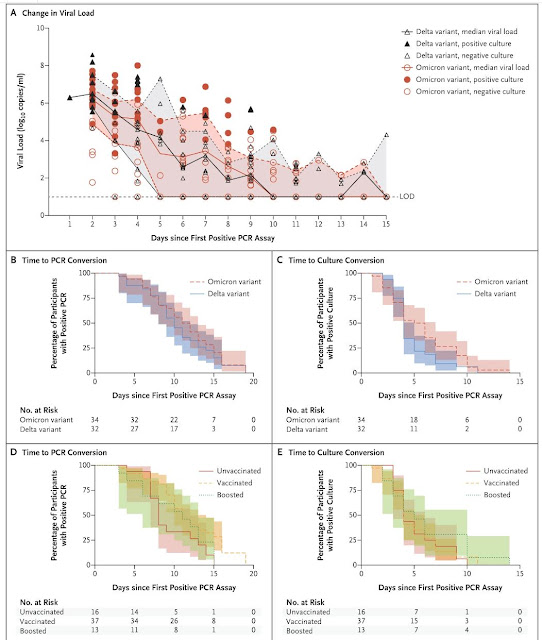Duration of Shedding of Culturable Virus in SARS-CoV-2 Omicron (BA.1) Infection
July 21, 2022
N Engl J Med 2022; 387:275-277
DOI: 10.1056/NEJMc2202092The B.1.1.529 (omicron) variant of severe acute respiratory syndrome coronavirus 2 (SARS-CoV-2) has a shorter incubation period and a higher transmission rate than previous variants.1,2 Recently, the Centers for Disease Control and Prevention recommended shortening the strict isolation period for infected persons in non–health care settings from 10 days to 5 days after symptom onset or after the initial positive test, followed by 5 days of masking.3 However, the viral decay kinetics of the omicron variant and the duration of shedding of culturable virus have not been well characterized.
We used longitudinal sampling of nasal swabs for determination of viral load, sequencing, and viral culture in outpatients with newly diagnosed coronavirus disease 2019 (Covid-19).4 From July 2021 through January 2022, we enrolled 66 participants, including 32 with samples that were sequenced and identified as the B.1.617.2 (delta) variant and 34 with samples that were sequenced and identified as the omicron subvariant BA.1, inclusive of sublineages. Participants who received Covid-19–specific therapies were excluded; all but 1 participant had symptomatic infection. This study was approved by the institutional review board and the institutional biosafety committee at Mass General Brigham, and informed consent was obtained from all the participants.
The characteristics of the participants were similar in the two variant groups except that more participants with omicron infection had received a booster vaccine than had those with delta infection (35% vs. 3%) (Tables S1 and S2 in the Supplementary Appendix, available with the full text of this letter at NEJM.org). In an analysis in which a Cox proportional-hazards model that adjusted for age, sex, and vaccination status was used, the number of days from an initial positive polymerase-chain-reaction (PCR) assay to a negative PCR assay (adjusted hazard ratio, 0.61; 95% confidence interval [CI], 0.33 to 1.15) and the number of days from an initial positive PCR assay to culture conversion (adjusted hazard ratio, 0.77; 95% CI, 0.44 to 1.37) were similar in the two variant groups (Figure 1A through 1C and S1 through S3, and Tables S3 through S5). The median time from the initial positive PCR assay to culture conversion was 4 days (interquartile range, 3 to 5) in the delta group and 5 days (interquartile range, 3 to 9) in the omicron group; the median time from symptom onset or the initial positive PCR assay, whichever was earlier, to culture conversion was 6 days (interquartile range, 4 to 7) and 8 days (interquartile range, 5 to 10), respectively. There were no appreciable between-group differences in the time to PCR conversion or culture conversion according to vaccination status, although the sample size was quite small, which led to imprecision in the estimates (Figure 1D and 1E).
In this longitudinal cohort of participants, most of whom had symptomatic, nonsevere Covid-19 infection, the viral decay kinetics were similar with omicron infection and delta infection. Although vaccination has been shown to reduce the incidence of infection and the severity of disease, we did not find large differences in the median duration of viral shedding among participants who were unvaccinated, those who were vaccinated but not boosted, and those who were vaccinated and boosted.
Our results should be interpreted within the context of a small sample size, which limits precision, and the possibility of residual confounding in comparisons according to variant, vaccination status, and the time period of infection. Although culture positivity has been proposed as a possible proxy for infectiousness,5 additional studies are needed to correlate viral-culture positivity with confirmed transmission in order to inform isolation periods. Our data suggest that some persons who are infected with the omicron and delta SARS-CoV-2 variants shed culturable virus more than 5 days after symptom onset or an initial positive test.
https://www.nejm.org/doi/full/10.1056/NEJMc2202092


9 件のコメント:
豪でコロナ感染・死者が記録的水準に、変異株が猛威
シドニー 26日 ロイター] - オーストラリアで26日、新型コロナウイルスによる入院者数が2日連続で最多記録を更新した。1日当たりの死者数も過去2番目の水準となった。
オミクロン変異株の派生型「BA.4」と「BA.5」が猛威を振るい国内の病院や介護施設が逼迫。この日の新規感染者は約5600人、死者は100人で23日に記録された102人に迫った。
過去7日間に確認された感染者は約33万人だが、当局は実数は2倍に達している可能性があるとみている。
過去最も深刻な感染に見舞われているクイーンズランド州のパラシェ首相は「団結して戦う時だ。ワクチン接種を受け、混雑時や屋内ではマスクを着用し、体調が悪ければ自宅に滞在してほしい」と呼びかけた。一方、医療現場での病床と前線勤務の拡充に務めると説明した。
同州は、保健当局のモデルをもとに8月末が感染のピークと予想している。
オーストラリアは最も厳格なコロナ規制を撤廃し、今年に入りコロナとの共存に政策転換している。
Shoko Egawa
@amneris84
ワクチン打ってないけど今なおコロナにかかってない自分、をアピールする人がいるけど、周囲の人がワクチン打ってているお陰で守られたのかも、という想像は働かないわけね。
https://twitter.com/amneris84/status/1551586901886320640
J Sato
@j_sato
Replying to
@amneris84
スプレッダーを量産する大迷惑ワクチンを、従来のワクチンと同じように考えない方がよいですよ。
お忙しいとは思いますが、ファクトとデータを見るようにすれば、コロナワクチン真理教から脱会できると思います。
https://twitter.com/j_sato/status/1551946648690905094
> NEJM
ついでに
BA5も
ケンタウロスも
調査熱望www
そんなしっかり分析しちゃ、らめぇ〜
https://twitter.com/trilliana_z/status/1552052163647795200?s=21&t=noBt13HLFtH__DXlbOWh5A
おらなんだかワクワクしてきたぞ!wwwwwwwwwwwwwwwwwwwwwwwwwwwwwwwwwwwwwwwwwwwwwwwwwwwwwwwwww
> ワクチン接種者は未接種者に謝れ!(爆wwwwwwwwwwwww
あっ謝罪とかなくて大丈夫っすwwwwwwwwwww><
大人しくどんどんおっちんで頂ければ全然OKっすwwwwwwwwwwwwwwwwwwwwwwwwwww
遺産は国の借金返済やら税金軽減にあてるとか遺書残していただければ大歓迎っすよwwwwwwwwwwwwwwwwwwwwwwwwwwwwwwwwwwwwwwwwwwwwwwwwwwwwwwwwwwwwwwwwwwwwwwwwwwwwwwwwwwwwwwwwwwwwwwwwwwwwwwwwwwwwwwww
サンプル数が少ないので信用に足りない 問題はないというでしょう 完全にぶっ壊れないと信じないでしょう なんたってディープ洗脳済みでしょうしね
今年中に、食った人が免疫不全で弱るのかはっきり出てきてほしいよな
100万人がみるみるうちに居なくなったら、やっとビビってくるだろうから
イギリスの後追いだとしたら、イギリス見たら分かるとおもう。
コメントを投稿